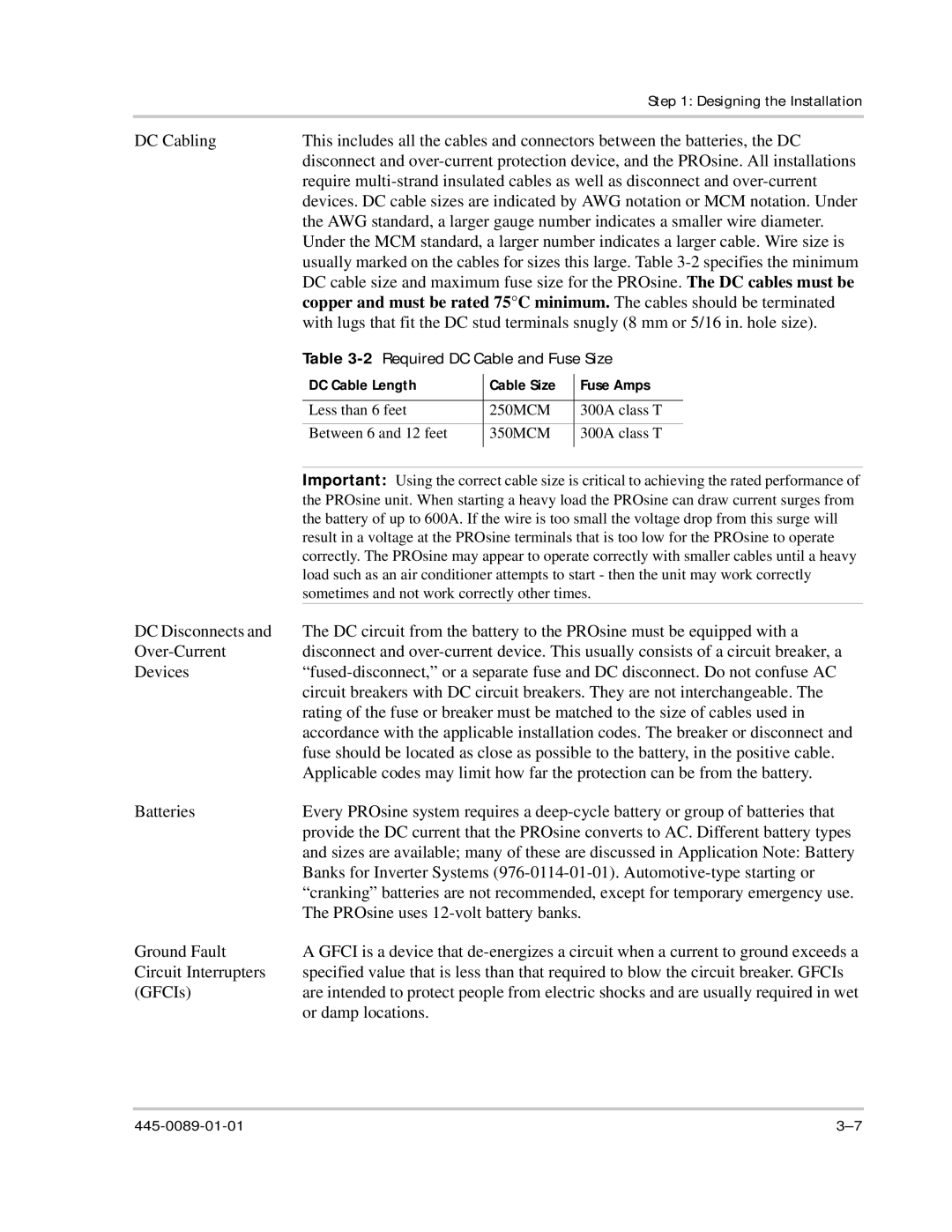|
|
|
|
| Step 1: Designing the Installation | |
|
|
|
|
| ||
DC Cabling | This includes all the cables and connectors between the batteries, the DC | |||||
| disconnect and | |||||
| require | |||||
| devices. DC cable sizes are indicated by AWG notation or MCM notation. Under | |||||
| the AWG standard, a larger gauge number indicates a smaller wire diameter. | |||||
| Under the MCM standard, a larger number indicates a larger cable. Wire size is | |||||
| usually marked on the cables for sizes this large. Table | |||||
| DC cable size and maximum fuse size for the PROsine. The DC cables must be | |||||
| copper and must be rated 75°C minimum. The cables should be terminated | |||||
| with lugs that fit the DC stud terminals snugly (8 mm or 5/16 in. hole size). | |||||
| Table | |||||
| DC Cable Length |
| Cable Size |
| Fuse Amps | |
|
|
| ||||
|
|
|
|
|
|
|
| Less than 6 feet |
| 250MCM |
| 300A class T | |
| Between 6 and 12 feet |
| 350MCM |
| 300A class T |
|
|
| |||||
| Important: Using the correct cable size is critical to achieving the rated performance of | |||||
| the PROsine unit. When starting a heavy load the PROsine can draw current surges from | |||||
| the battery of up to 600A. If the wire is too small the voltage drop from this surge will | |||||
| result in a voltage at the PROsine terminals that is too low for the PROsine to operate | |||||
| correctly. The PROsine may appear to operate correctly with smaller cables until a heavy | |||||
| load such as an air conditioner attempts to start - then the unit may work correctly | |||||
| sometimes and not work correctly other times. | |||||
DC Disconnects and | The DC circuit from the battery to the PROsine must be equipped with a | |||||
disconnect and | ||||||
Devices | ||||||
| circuit breakers with DC circuit breakers. They are not interchangeable. The | |||||
| rating of the fuse or breaker must be matched to the size of cables used in | |||||
| accordance with the applicable installation codes. The breaker or disconnect and | |||||
| fuse should be located as close as possible to the battery, in the positive cable. | |||||
| Applicable codes may limit how far the protection can be from the battery. | |||||
Batteries | Every PROsine system requires a | |||||
| provide the DC current that the PROsine converts to AC. Different battery types | |||||
| and sizes are available; many of these are discussed in Application Note: Battery | |||||
| Banks for Inverter Systems | |||||
| “cranking” batteries are not recommended, except for temporary emergency use. | |||||
| The PROsine uses | |||||
Ground Fault | A GFCI is a device that | |||||
Circuit Interrupters | specified value that is less than that required to blow the circuit breaker. GFCIs | |||||
(GFCIs) | are intended to protect people from electric shocks and are usually required in wet | |||||
| or damp locations. |
|
|
|
|
|
